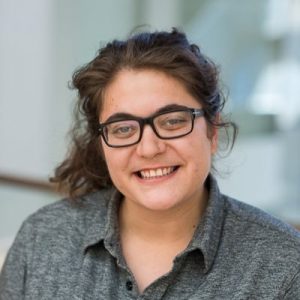
The Department of Psychology is pleased to welcome new faculty member Rosa Lafer-Sousa. Lafer-Sousa earned her bachelor’s degree in neuroscience at Wellesley College. After graduation, she worked as a lab manager in Bevil Conway’s labs at Wellesley and Harvard Medical School. She then pursued graduate training at MIT, completing a PhD in Brain and Cognitive Sciences in 2019. Most recently, she was a postdoctoral fellow at the NIH (NIMH), working in the Unit on Neurons, Circuits, and Behavior.
Hometown: I grew up in San Antonio, Texas, though I spent most of my summers either in Portugal (my father’s homeland) or in the small research village Woods Hole, Massachusetts, where my mother was a summer investigator.
How did you get into your field of research? My path into vision science began with art. Growing up, I was equally drawn to science and to making art, and for a long time I thought I’d have to choose between the two. In college, I took an interdisciplinary course called Vision and Art: Physics, Physiology, Perception, and Practice. It completely changed my trajectory. I realized that studying vision could bring together my practice of art, my love of science, and my curiosity about the mind—all in one field.
I study the neural and cognitive basis of visual perception: how the raw sensory signals our eyes recover from the world are transformed into meaningful internal representations that guide behavior. I’m especially interested in how the brain resolves ambiguities in the sensory signal, including how and when top-down factors like what we know about the world influence what we perceive.
My current work aims to uncover causal links between activity in specific brain circuits and what we perceive. We use techniques like optogenetics, electrophysiology, and fMRI in nonhuman primates to determine how neural activity at different stages of the visual pathway gives rise to, and constrains, perception and behavior. Ultimately, the goal is to build a mechanistic understanding of perception that could inform treatments for visual disorders and guide the development of visual prosthetics.
What attracted you to UW–Madison? UW–Madison has a long tradition of excellence in advancing psychological science and training future generations of leaders in the field. The collaborative atmosphere, strong support for early-career faculty, and the university’s deep commitment to the Wisconsin Idea all made it feel like the right place to start my lab. Most of all, I felt at home among the faculty in the psychology department.
What’s the most important lesson you wish to convey to students? Science is a human endeavor. It takes persistence, creativity, and community. I want students to know that it’s okay not to have all the answers right away. The real progress often comes from asking good questions, working collaboratively, and staying open to being surprised by the data.
Do you feel your work relates to the Wisconsin Idea? Yes! The Wisconsin Idea emphasizes that the work of the university should benefit people beyond the campus. My research connects to this by addressing fundamental questions about the brain that have direct implications for health, technology, and society. In addition, I see mentoring and training the next generation of scientists as a way of extending that impact outward.
What’s something interesting about your area of expertise that will make us sound smarter at parties? Every human sees the world a little differently. For example, even if two people look at the same ripe strawberry, the exact shade of red they experience may not be identical. Our brains construct color from noisy signals, and that construction can vary across individuals. Color is less an objective property of the world than a shared illusion our brains agree on.
Any hobbies or interests outside of your work? Outside of the lab, I’m deeply engaged in advocacy for science as a public good. I believe that research should not only advance knowledge within the academy but also strengthen our democratic institutions and improve people’s lives. I’ve worked with colleagues across the country to build community, raise awareness, and speak up when science and public institutions are at risk. I see this kind of engagement as an extension of my role as a scientist and resonates strongly with the Wisconsin Idea. When I’m not working or organizing, I enjoy hands-on activities like making art or woodworking, hobbies that give me a different but equally rewarding way to build and create.